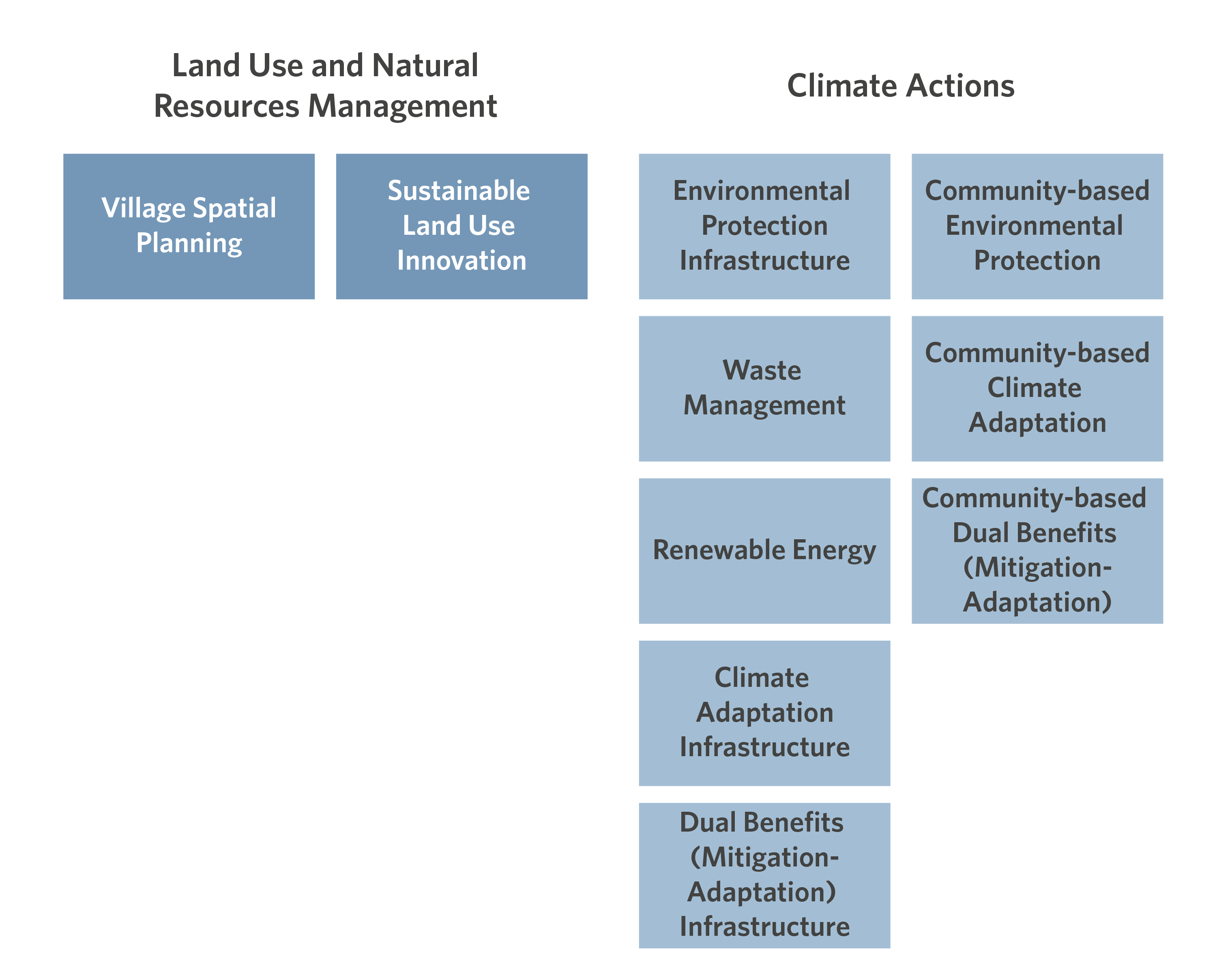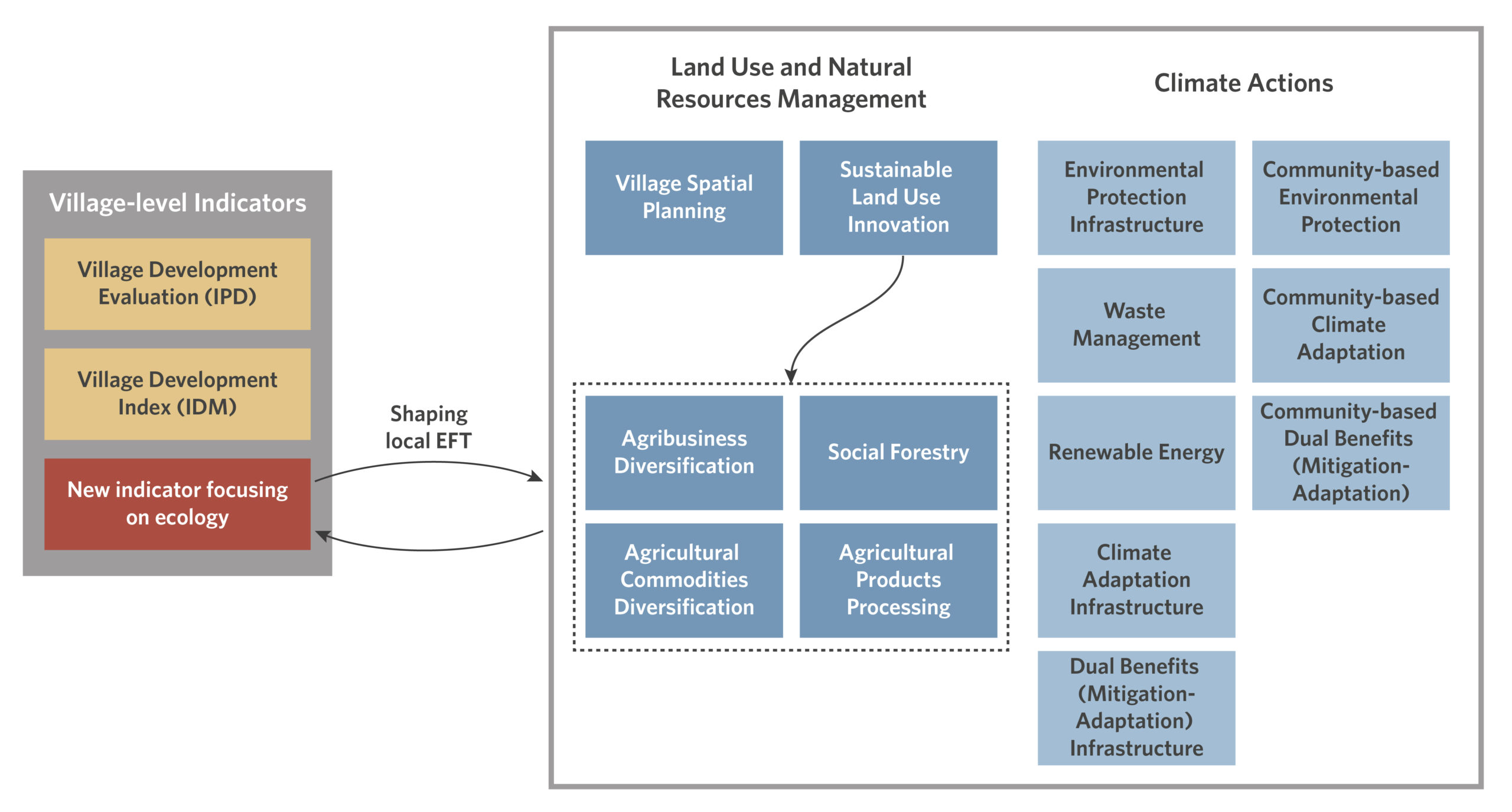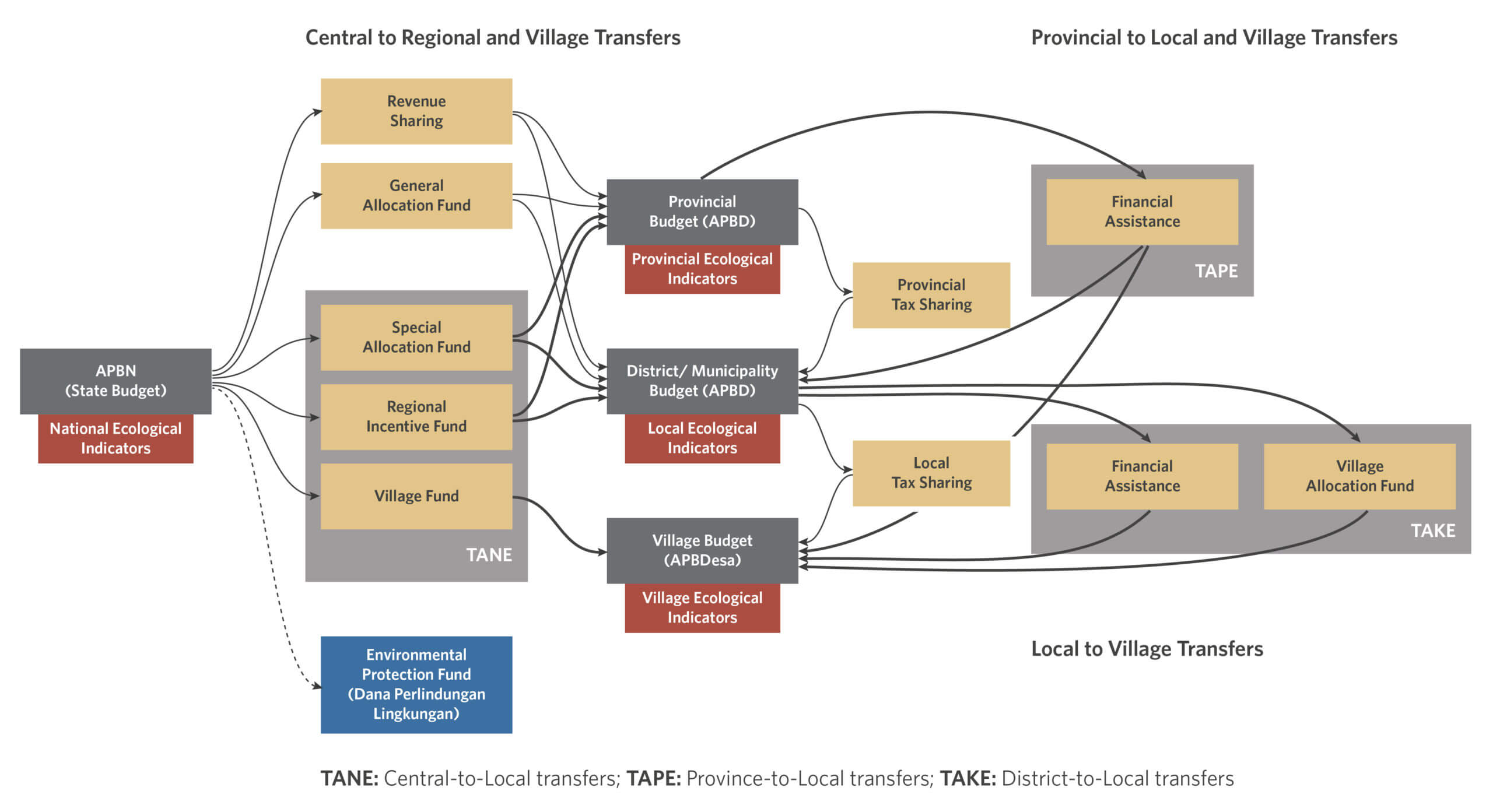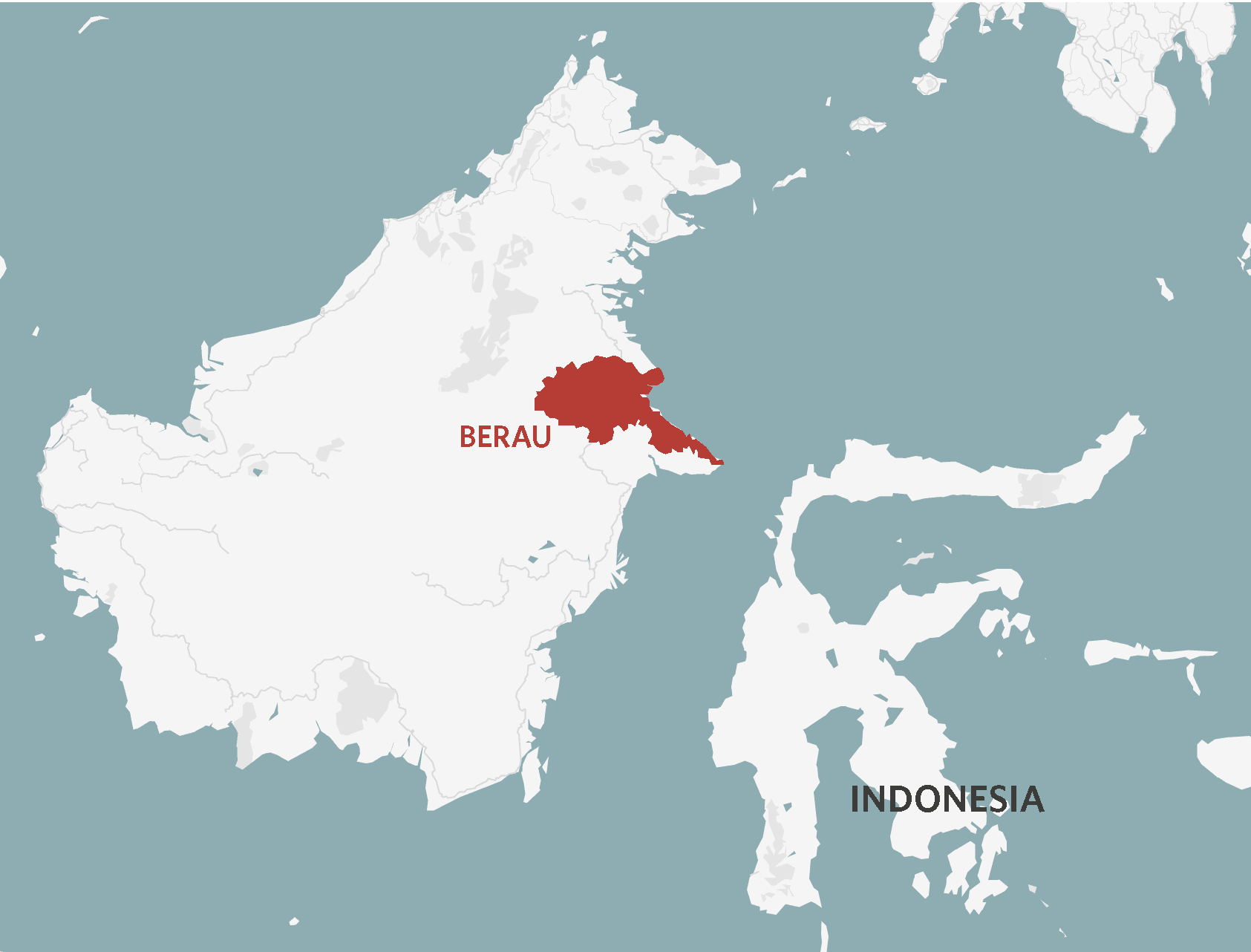Villages are the smallest unit of administration in Indonesia’s vast and multi-tiered governance system. Central government targets for achieving sustainability goals should ideally trickle down to all levels of the government, culminating in clear action plans for the village unit. However, there is evidence that villages are not making sustainable land use programs a major part of their spending: Our work shows this is true even in regions where there is a strong commitment by the Provincial Government to accelerate green growth, such as in East Kalimantan (CPI, 2018).
There is currently a strong push to develop new fiscal transfer instruments that would provide monetary incentives to regions that achieve certain ecological goals. Many reforms have been passed over the past two years that have created rewards for certain achievements related to environmental sustainability. These have included rewards from the central government for waste reduction, and rewards at the locality level to its sub-localities for other ecological performance factors. It is important that these developments are underpinned by clear achievement metrics that truly indicate an improvement in the sustainability of the region. There is a growing urgency, particularly during the current pandemic-induced economic recession, to ensure that programs that foster a healthy environment and resilience are being supported.
This paper proposes a potentially sweeping, but relatively practical reform to the existing Village Development Index to encourage villages across Indonesia to adopt sustainability targets. First, by enhancing the index to include more sustainability indicators. Second, by using it as a basis for new fiscal transfers to incentivize villages.
This paper proposes a two-part approach for a potentially sweeping, but relatively practical reform to encourage villages across Indonesia to adopt sustainable practices.
The first part of the approach recommends that the current relevant indices, namely the Village Development Index (Indeks Desa Membangun – IDM), be enhanced to factor in better sustainability indicators that are applicable to all villages across Indonesia, despite differences in natural resource characteristics.
The second part of the approach recommends that this new index, which we propose to call the Sustainable Village Development Index or Indeks Desa Membangun Plus (IDM+), becomes the basis for new fiscal transfer instruments to incentivize villages to achieve their sustainability goals.
The following findings form the basis of our recommendations:
- Existing development indicators and evaluation tools are inadequate to mainstream environmental sustainability targets to the village-level
Existing evaluation methods are not adequate to account for – let alone reward – village actions to reach the implementation of Sustainable Development Goals (SDGs) or sustainable development in general. The existing evaluation indicators made by the central government ministries for village-level governance—Village Development Evaluation (Index Pembangunan Desa—IPD) and Village Development Index (Indeks Desa Membangun—IDM) — are unable to holistically measure the environmental performance of villages. IPD is more focused on measuring socio-economical aspects and disaster resilience. And though IDM has an ecological resilience index, it only assesses a narrow scope of environmental quality and disaster risk management. - Despite the existence of a national framework for Sustainable Development Goals (SDGs), there are no evaluation indicators for SDGs that would result in fiscal transfers to villages
Despite the existence of a national framework on SDGs, there are no SDG evaluation indicators being actively used by localities for assessing villages. As a result, current fiscal transfers to villages provide no support for villages to improve on these non-existent indicators.
Evaluation methods need to be updated to reflect ecological factors in support of sustainable development. SDGs are the best basis for this, as they have been adopted at national levels through Presidential Regulation No 59/2017 and absorbed into Indonesia’s Mid-Term Development Plan (Rencana Pembangunan Jangka Menengah – RPJMN). The Mid-Term Development Plan calls for improving environmental quality, disaster resilience, and low carbon development, among other things. There are more than 50 SDGs related to ecological indicators tailored to Indonesia’s 2020 – 2024 development agenda. Despite that, we found that the lower tier of the government has no or limited sustainability indicators.
This could be because sustainability indicators are clear at the national level, but rather ambiguous at the subnational level, or the monitoring and evaluation procedures have not properly trickled down to the lowest tier of government. For example, when it comes to villages, our study in Berau shows that there are no indicators that can measure performance for land use and natural resource management. Similarly, when it comes to low carbon development, villages have no metrics applicable to them for renewable energy, or mitigation-adaptation infrastructure. - New fiscal transfer mechanisms need to be based on ecological indicators that can be universally applied across all regions, but minimize bureaucratic disruption.
Evidence shows the importance of fiscal incentives in supporting local actors for delivering ecological outcomes, particularly in the land-use and forestry sector (See Li 2016; Sutiyono et al. 2018; Thuy Tu et al. 2013; Wahyudi and Wicaksono 2020). This is because incentives are pivotal to induce changes in entrenched behaviors and policies at all levels of governments (Thuy Tu et al. 2013). Furthermore, basing fiscal transfers on conservation performance is also relevant in the context of COVID-19, where limited fiscal capacities calls for fiscal efficiency: to use as little public money as possible to deliver the biggest outcomes.
Generally, fiscal transfer instruments have an underlying purpose to provide all regions with equitable opportunities nationwide and account for differences in GDP, human development, and poverty rate, among other things. To provide a push for improvement across the nation, villages that have the highest environmental performance need to be rewarded by effective, transparent, and equitable mechanisms. Therefore, implementing new ecological fiscal transfer mechanisms requires having sound ecological indicators that are applicable across all regions, yet able to account for unique differences. An equitable fiscal transfer based on ecological indicators should be able to absorb differences in natural resources, topography, weather, condition of forests or marine areas, and agricultural activities.
The indicator must be flexible in two ways — it must be broad enough to be relevant for all villages, and it must be flexible enough to be tailored to specific localities.[1] It must also be feasible to implement, and able to tap into existing bureaucratic processes instead of reinventing the wheel.
CPI proposes a Sustainable Village Development Index (“IDM+”).
Based on these findings, CPI proposes a new indicator called the Sustainable Village Development Index (IDM+) that would support a regency-level Ecological Fiscal Transfer capable of translating SDG priorities to the village level.
IDM+ uses an existing index and adds 10 different ecological indicators which is divided into two main categories; land-use and natural resource management, and climate actions. The index adds important ecological performance indicators but does not create a new index. It instead builds on existing instruments already used in villages, to avoid lengthy bureaucratic adaptations.
The 10 IDM+ indicators are designed to be universally applicable across all villages, while also flexible to take on local characteristics. For example, some villages with specific goals might take on additional sub-indicators beyond the main 10 to showcase high performance.
There are two main indicators in the land-use/natural resource management category, which are village spatial planning and land-use innovation. Meanwhile, there are eight main indicators in the climate action category, such as environmental protection infrastructures, waste management, renewable energy, community-based environmental protection, climate adaptation, community-based climate adaptation, dual benefits (mitigation and adaptation), as well as community-based dual benefits.
Figure ES1. IDM+ main indicators

As a case study, CPI looked at the Berau District of East Kalimantan to understand how such a transfer mechanism might be applied. We evaluated 100 villages based on the 10 IDM+ indicators as well as an additional 4 sub-indicators. The additional four indicators are agribusiness diversification, agricultural commodities diversification, agricultural products processing, and social forestry.[2]
IDM+ measures 10 different ecological indicators. It is thus more comprehensive than existing ecological evaluations, while also flexible to take on local characteristics. For example, in the case of Berau, IDM+ could have 4 sub-indicators in addition to the main 10.
Figure ES2. IDM+ Ecological Indicators in Berau

IDM+ is complementary to a rich array of initiatives taken up by civil society organizations and academia in recent years to push for Ecological Fiscal Transfers. These initiatives recommend including ecological indicators as a criterion to determine the amount of fiscal transfer received by local government beneficiaries.[3] There are three categories of reform that are currently being discussed: Central Ecological Fiscal Transfer (Transfer Anggaran Nasional Berbasis Ekologi—TANE), Provincial Ecological Fiscal Transfer (Transfer Anggaran Provinsi Berbasis Ekologi—TAPE), and Regency Ecological Fiscal Transfer (Transfer Anggaran Kabupaten Berbasis Ekologi—TAKE).
Figure ES3. Fiscal instruments currently undergoing discussion for reform.

Many local governments are currently exploring EFT mechanisms, with the support of central government. Therefore, there is an opportunity to enrich this discourse and fill the gaps in measuring ecological performance to deliver on the ground impacts.
The Sustainable Village Development Index (IDM+) can form the basis for direct fiscal incentives to villages
There are various fiscal instruments that regional governments can use to incentivize village performance as measured by IDM+.
In the case of regency-to-villages fiscal transfer, there are a few fiscal instrument options that can be used for transfer funds to villages. The first one is Financial Assistance (Bantuan Keuangan Kabupaten), and the second one is Village Fund Allocation (Alokasi Dana Desa). The choice on which instrument can be connected with IDM+ indicator is contingent on fiscal capacity, political support, and development priorities.
Applying IDM+ in Berau Regency, East Kalimantan Province as a Test Case
Figure ES4. Berau Regency, East Kalimantan, Indonesia

Results of our survey in Berau’s 12 subdistricts, show that in general, most villages score Very Low (48/100) and Low (35/100) on the performance scale. Survey results show that diversification of agricultural commodities (which contributes to resilience) has the strongest score, meanwhile village spatial planning and social forestry has the lowest performance across villages. We find that IDM+ provides a wide illustration of the state of environmental performance across villages in Berau—illuminating which aspect needs the most support.
Based on the simulation, we found that for Berau it is recommended to opt for the use of mixed fiscal instruments for ecological fiscal transfer. That is, each instrument can be targeted for specific environmental objectives so that if mixed together, they can create a fiscal transfer system that can both incentivize villages with high performance while assisting villages with low performances. For example, Village Fund Allocation (ADD) instrument can be used for village incentives, but a Financial Assistance instrument can be used to help low performance villages perform better—acting as an affirmative action.[4] The use of blended fiscal instrument must be meticulously planned to promote intervillage competition on improving ecological programs, all while the government explores possibilities of using a new source of non-government funding, such as grants or result-based payments.
Based on our calculation, villages that did well and achieved a High on the performance scale, stood to gain an additional IDR 200 million on average from ADD, which is an increase of about 12-18% from their original fiscal allocations. However, this will also entail a reduction for the other villages that perform poorly. Hence, to prevent significant resistance to the introduction of ecological fiscal transfer in Berau, the district should leverage other instruments or other sources of non-government funding to complement ADD. This way, at least the low performing villages can receive similar fiscal allocation from the regency to improve their environmental governance capacity.
Policy Recommendations: Moving forward with effective fiscal mechanisms based on IDM+ to incentivize environmental sustainability in villages requires subnational government initiatives and central government support
Based on our simulation, we recommend policy support for the Central Government:
- Continue to endorse the implementation of EFT across localities in Indonesia at the political and regulatory levels. Wide political support, particularly by the Ministry of Finance, is pivotal for local governments to tailor fiscal transfers underpinned by sustainability indicators.
- Explore the possibility of incorporating IDM+ into IDM by the Ministry of Villages. This would help mainstream ecological performance evaluation down to the village-level across Indonesia.
We also recommend several key steps for the Berau Government:
- Ensure clear and transparent dissemination on pre and during policy implementation, that IDM+ is an enhanced mechanism, built from the existing performance indicators and its associated fiscal instruments.
- Ensure commitment and leadership from the heads of local villages. This policy involves multiple stakeholders with the principle of inclusive sustainable development, i.e. all villages have equitable opportunities and access to resources to improve their performance. Thus, this requires leadership and cooperation between the government, the private sector, and other development partners.
- Knowledge and capacity building on IDM+ to enhance and develop knowledge tools, equipment, and other resources needed for successful implementation and continuous improvement on village sustainability.
[1] Under Law 06 Year 2014 on Villages, villages are mandated to help regency’s development priority, including those with sustainability goals. This is also in line with Ministry of Village Regulation 13 Year 2020 on the use of village fund where SDGs program must be prioritized. The lack of coverage for SDGs in the existing IDM indicator means there is a need for villages to have sound ecological indicators.
[2] On the addition of social forestry in the indicator: although social forestry programs are implemented in the forest area which is under the authority of provincial or central government, the village governments have pivotal roles in assisting the licensing process for social forestry. Hence, the “performance” for this indicator will refer to this aspect.
[3] Since 2019, there has been emerging advocacy movement for ecological fiscal transfer which was adopted by several localities, such as Indonesia’s Jayapura Regency (2019), Nunukan Regency (2019), and North Kalimantan Province (2019). For more detail see Suryaputra (2019)
[4] In 2020, the Ministry of Finance set the regulation that allocates Village Fund for affirmative action up to 1.5% of the total fund for all villages in Indonesia. The affirmative allocation is defined as the percentage of the total Village Fund divided by all villages with high poverty rate nationwide. See Article 6 (4) Ministry of Finance (PMK) regulation 205 Year 2019.

